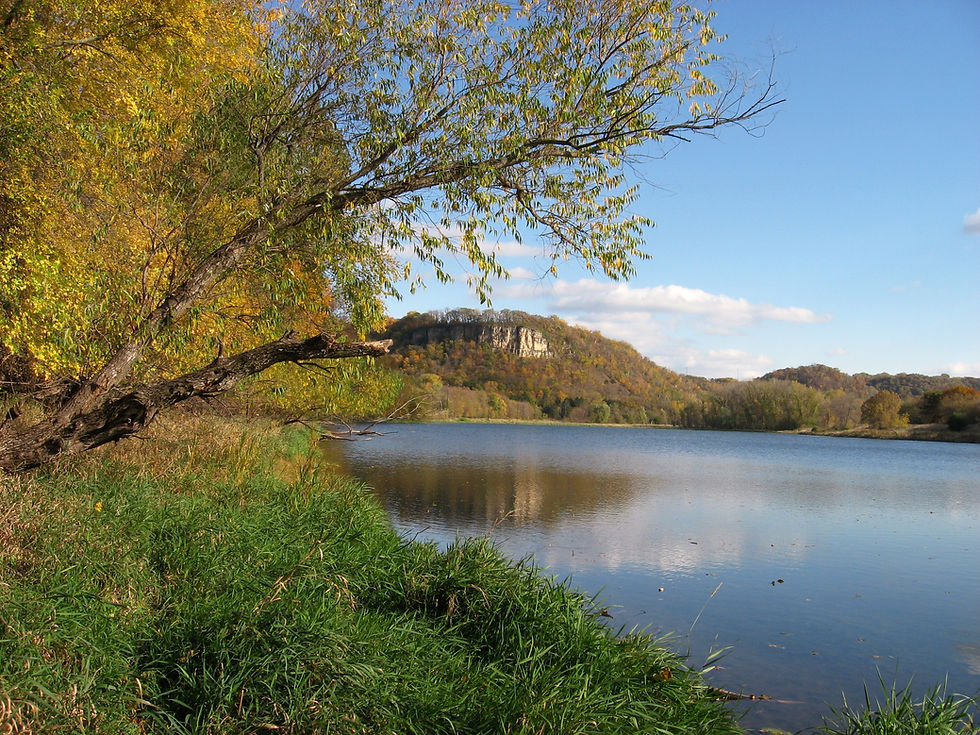Bald Eagles, 1930's History on Rattlesnake Bluff and The Legend Of White Lightning" Continues
- wacoutanaturenotes
- Apr 21
- 4 min read
This post will feature interesting bald eagle behavior, little known activity on top of Rattlesnake Bluff and new sightings of the elusive goat.

Since my last post where you observed a newly hatched eaglet, another eaglet has appeared on the scene.
This photo was taken 20 days after the previous one and shows considerable development. Notice the size of their talons in comparison to the rest of the body.
Michael's ring security camera has provided another interesting facet of eagle behavior not very well known. Anyone who maintains artificial nesting boxes for bluebirds, knows how vile the nest becomes after the young hatchlings excrete their waste for two or three weeks prior to hatching.
Eaglets on the other hand, spend 10 to 12 weeks at the nest before they are capable of flight. To avoid an unpleasant nest environment they possess an unique innate way of excreting their waste known as "poop shooting."
At about two weeks of age, the eaglets are strong enough to get to the edge of the nest and let it fly!
Some bird species like the common grackles remove fecal sacs of the hatchlings from the nest and deposit the sacs in water to reduce the smell which could attract predators. During grackle nesting season, we frequently find their fecal sacs in our birdbath.

On my January 17th blog post, I mentioned for the past three years the Frontenac State Park has employed the use of 20 goats and prescribed fires to control invasive buckthorn on goat prairies on the south side of Rattlesnake Bluff.
On April 8th. the second of two spring burns was conducted near the face of the bluff. Many of you may recall this is the same area where "White Lightning" has been recently observed.
As Kathy and I watched the fire take place, we wondered how the goat would be impacted. You will learn more about that later in this post.

Prescribed burns provide numerous benefits enhancing overall prairie health and at the same time help to hold invasive plants in check. The burns stimulate new growth, improve soil health and recycle nutrients.
In addition, new opportunities are afforded a variety of bird species such as northern flickers.

Flickers like other woodpeckers are capable of climbing trees and searching for their food. However, they much prefer to find their food on the ground.
At the top of their list of desired foods are ants. These birds will dig in the dirt to find them and use their barbed tongue to lap up the ants.
Two days after the prairie was burned on the west end of Rattlesnake Bluff, I observed a flock of over 50 flickers on the ground scouring up insects.

Within the past couple months, I have learned from Lorry Wendland- a local historian and respected writer, Wally Siewert,- a long time employee at Frontenac State Park and Jeff Ekblad - Goodhue County Surveyor, that from approximately 1928 to 1941 there was a functioning Air Beacon System on top of Rattlesnake Bluff.
This system was developed to assist pilots in delivering mail for the FAA Transcontinental Air Route. These beacons allowed air mail delivery at night before the use of radar.
In 1941, these beacons and mechanical sheds were removed leaving virtually no evidence above ground of their existence.

On April 10th, I had the good fortune to join Jeff Ekblad, Wally Siewert, Lorry Wendland and Amy Jay, Asst. Manager for Frontenac State Park, on an adventure to search for the exact location of the air beacon.
With Jeff's expertise and new technology, the exact location was found. To validate this discovery, small pieces of concrete from the support pad for the beacon were found.
For readers interested in learning more about this era, I suggest you read a new book that will be available in 2026 written by Lorry on the "History Of Frontenac State Park."

I mentioned earlier in this post about the concern Kathy and I had for the well being of the white goat as we watched the bluff being burned on April 8th.
At the conclusion of the beacon adventure, Amy took a walk through the forest adjacent to the prairie to check on the success of the fire against the invasive buckthorn. Suddenly, I observed her motioning me to join her. As I approached her in the woods, I noticed the white goat resting comfortably nearby. I guess our concerns were unfounded.

On a recent drive on a rural rustic road (low maintenance), Kathy spotted this eastern screech owl looking out of an abandoned wood duck nesting box. This rufous colored owl is fairly common in southeast Minnesota.

Starting April 8th thru today April 20th, we have observed this immature red-tailed hawk frequenting a large cottonwood tree in our yard. During the first part of April, large groups of these hawks are in the midst of their spring migration.




Thanks for the information and the observations you are sharing, really appreciated